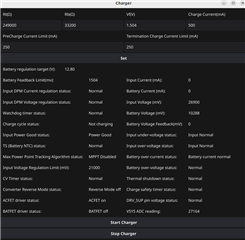Other Parts Discussed in Thread: BQ25756
Tool/software:
Hello,
we are trying to charge an e-bike battery with a custom board using the BQ25750 charger.
We have tested the board with various lipo cells number combinations and it operates correctly.
The problem arises when we try to charge an ebike battery pack. The specific pack is the RPH0002 which is a 54.6V battery pack.
The input voltage for the BQ25750 is 24V with sufficient current.
The problem is that the charger is not starting. This pack has BMS inside and different port for charging and at these pins has zero Volts.
We have disabled the precharge and the termination cycles but still nothing. It seems that the BQ25750 is not starting when it sees 0V at the feedback resistor.
All the status registers of the chip are clear. Please check the screenshot attached.
We tested the battery pack with its own charger and it charges correctly.
Does anybody has any idea how to save this design?
Thank you.




